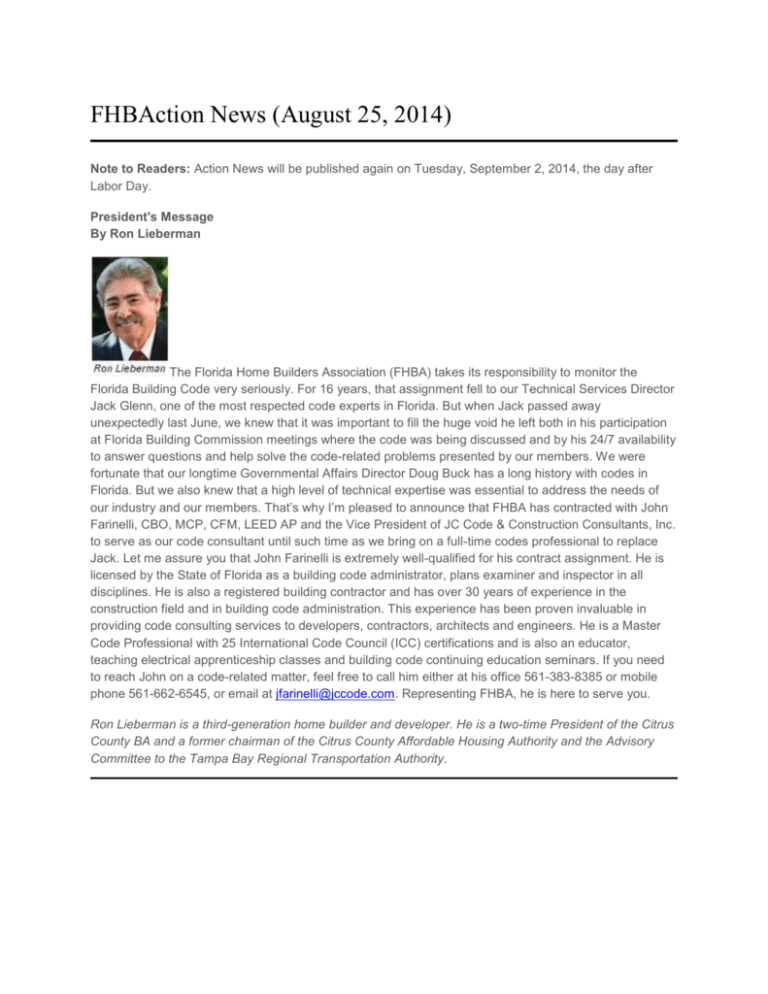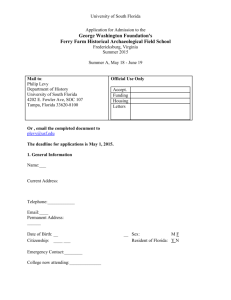FHBAction News 8-25-14.do - Treasure Coast Builders Association
advertisement

FHBAction News (August 25, 2014) Note to Readers: Action News will be published again on Tuesday, September 2, 2014, the day after Labor Day. President's Message By Ron Lieberman The Florida Home Builders Association (FHBA) takes its responsibility to monitor the Florida Building Code very seriously. For 16 years, that assignment fell to our Technical Services Director Jack Glenn, one of the most respected code experts in Florida. But when Jack passed away unexpectedly last June, we knew that it was important to fill the huge void he left both in his participation at Florida Building Commission meetings where the code was being discussed and by his 24/7 availability to answer questions and help solve the code-related problems presented by our members. We were fortunate that our longtime Governmental Affairs Director Doug Buck has a long history with codes in Florida. But we also knew that a high level of technical expertise was essential to address the needs of our industry and our members. That’s why I’m pleased to announce that FHBA has contracted with John Farinelli, CBO, MCP, CFM, LEED AP and the Vice President of JC Code & Construction Consultants, Inc. to serve as our code consultant until such time as we bring on a full-time codes professional to replace Jack. Let me assure you that John Farinelli is extremely well-qualified for his contract assignment. He is licensed by the State of Florida as a building code administrator, plans examiner and inspector in all disciplines. He is also a registered building contractor and has over 30 years of experience in the construction field and in building code administration. This experience has been proven invaluable in providing code consulting services to developers, contractors, architects and engineers. He is a Master Code Professional with 25 International Code Council (ICC) certifications and is also an educator, teaching electrical apprenticeship classes and building code continuing education seminars. If you need to reach John on a code-related matter, feel free to call him either at his office 561-383-8385 or mobile phone 561-662-6545, or email at jfarinelli@jccode.com. Representing FHBA, he is here to serve you. Ron Lieberman is a third-generation home builder and developer. He is a two-time President of the Citrus County BA and a former chairman of the Citrus County Affordable Housing Authority and the Advisory Committee to the Tampa Bay Regional Transportation Authority. Gulf County Eyes Affordable Housing Federal funds made available to the state of Florida are helping bring affordable housing to Gulf County along Florida’s Forgotten Coast. Mark Du Mas, president and founder of The PACES Foundation, told Gulf County Commissioners last week that an application for loan dollars to construct affordable housing had been approved by Governor Rick Scott under the federal HOME program. The award was $5.5 million and will be used to build 50 two-, three- and four-bedroom townhomes renting for between $450 and $650 a month on a 40-acre parcel in the city of Port St. Joe. The funds are distributed to the states by the Department of Housing and Urban Development (HUD). Du Mas praised Scott’s support of housing dollars for smaller counties, noting that in the past more than 90 percent of Florida housing funds end up in larger counties such as Orange, Miami-Dade, Broward and Duval. The PACES Foundation made an application roughly two years ago to secure housing tax credits it would leverage for funding in the private market to underwrite building more than 75 affordable housing units. The city of Port St. Joe amended the zoning of the parcel to accommodate affordable housing, but the foundation fell short in the lottery system used to distribute the housing tax credits. Du Mas said the foundation would continue to pursue the tax credits, but the HOME dollars allowed the foundation to move ahead on the initial units. First-Time Buyers Face Uphill Climb The inventory of new homes available to first-time home buyers in America is dwindling. The number of U.S. homes for sale in the bottom third of the market (below $198,000) fell 17 percent in June compared with a year earlier, according to an analysis of 31 large U.S. metropolitan areas by the Seattle-based brokerage firm Redfin. The supply was up 3 percent in the middle market and jumped 15 percent at the top, the data show. The inventory of all existing homes for sale rose 6.5 percent in June from a year earlier to 2.3 million, an increase from a 13-year low of 1.8 million in January 2013, according to the National Association of Realtors. That's a 5.5-month supply at the current sales pace, less than the six months that is considered equilibrium between buyers and sellers. Average list prices on the low-end jumped 15 percent in June from a year earlier, and increased 13 percent in the middle and 9 percent at the top, according to Redfin's analysis of large metro areas. First-time purchasers accounted for 28 percent of all sales of previously owned homes in June, down from about 40 percent historically, according to NAR. The contrast is starker in the newhousing market, where home builders are focusing on move-up buyers. In May, home builders reported that only 16 percent of new-home purchases were made by first-time buyers, the lowest in 15 years of data, according to David Crowe, chief economist for the National Association of Home Builders. That's further limiting supply as builders shift away from constructing entry-level homes. Tight credit has made it more difficult for young buyers, who have relatively high unemployment, weak wage growth and lower credit scores, Crowe said. The supply of cheaper new homes "isn't there because young people are still up against these financial barriers," Crowe said. "The builders are responding to the customer that is active in the market. It will be at least two years before there is a measurable change in the share of sales going to first-time homebuyers." College Helps with Workforce Training Community colleges are stepping up to help the building industry meet the challenge of creating a skilled workforce. The latest example is Daytona State College which is working with the Volusia Building Industry Association (VBIA) and the Flagler Home Builders Association to train students for careers in the construction trades. According to a recent report in the Daytona Beach News-Journal by reporter Bob Koslow, the college held a focus group meeting with several area builders and representatives of related businesses to get their suggestions on what skills those new construction-training programs should offer. “How to use a screwdriver and the difference between a ball-peen and claw hammer,” said Mike Caron, an estimator and salesman with Halifax Plumbing in Port Orange. “They can’t come out of high school and be a service tech right away. They have to start at the bottom and work their up. But they need the basics and they’re not getting them.” Budd Severino, president of Advanced Home Exteriors in Daytona Beach, added, “How to read a tape measure. They need a work ethic to show up to work every day.” “The industry was devastated when many workers left the area or found new occupations and it’s hard to rebuild,” said Sandy Burke Bishop, VBIA’s executive director. The core issue, according to several area builders, is that the public school systems and parents are urging kids to skip vocational educational opportunities and go to college. “The students have to know it’s OK to get dirty and that construction is a good job and they can make good money,” said debi Peterson, executive officer of the Flagler Home Builders Association. VBIA is in talks with the Academy of Construction Technology to expand its training programs into some Volusia County high schools, said Bishop. The academy has an established curriculum in use in the Orlando area and would provide an early training program in the high schools with on-the-job training opportunities with local companies. Palm Beach County Prices Are Soaring Emboldened by a real estate market still gaining ground more than a year into recovery, Palm Beach County home sellers are bumping up their expectations and listing prices. In July, the median asking price in Palm Beach County on single-family homes and condominiums was $290,500, a 13.3 percent increase from the same time last year, according to a new report from the housing research firm Trulia. The increase in asking price, a gauge of future sales price trends, ranks Palm Beach County sixth nationally for listing gains in July, according to a measure of 100 large metro areas. “Demand for homes is strengthening because the economy is recovering, and, in many markets, inventory still looks tight,” said Jed Kolko, Trulia’s chief economist. Nationally, asking prices were up 7.8 percent in July from the same time in 2013. Kolko said past measures have shown areas hit hardest by the real estate crash typically had the highest gains in asking prices as the market rebounded. But the July measure was missing some of the usual suspects, including Phoenix and Las Vegas. It was also notable, Kolko said, that only one California region was in the top 10. “There are areas that have seen price gains slow down because the foreclosure crisis happened earlier and the recovery came earlier,” Kolko said. “Florida is still in that recovery mode.” Palm Beach County Realtors said the recovery has spurred more sellers to action. New listings of single-family homes in June were up 31 percent from the same time in 2013, according to a Realtors Association of the Palm Beaches report. Homes sat on the market for a median of just 53 days, and sellers got, on average, 93 percent of their list price. Home Buyer-Renter Ratio Now 60/40 Southwest Florida's apartment complexes are 96.2 percent occupied and Blue Rock Partners, LLC of Tampa is buying and upgrading three projects in Lee County to the tune of $44.3 million. The activity is part of a national trend that's especially strong in Southwest Florida, said Jack McCabe, a Deerfield Beach-based real estate consultant who tracks housing markets in Southwest Florida and elsewhere. "We're in this paradigm shift right now, especially in Florida." In 2007 it was 70 percent home buyers and 30 percent renters. Now it's 60 percent home buyers and 40 percent renters." McCabe said rental demand has continued to increase due in part to "renters with no choice,” meaning they had a short sale, got behind on their mortgage or had a foreclosure. “Their credit's taken a pretty good hit,” said McCabe. “Banks are saying they're going to relax credit standards. I still haven't seen it happening." As a result, both builders and buyers of complexes are stepping up their game. Commercial real estate agent Jonathan Richards of CBRE, which specializes in multi-family properties, said the apartment market was made even tighter because at the height of the boom in 2004 and 2005. "We lost a lot of apartment complexes to condo conversion, or they were going to come out of the ground of apartments but they became condos," Richards said. David Cobb, regional director in the Naples-Fort Myers area for housing data provider Metrostudy, which tracks pricing and new-home construction, said another reason for apartments' current popularity is that a lot of new arrivals are prime candidates to rent. "Southwest Florida's been creating 15,000 jobs a year, most of those service jobs," he said. "They're not the sort of people who are going to be able to afford to live in a master-planned single-family community." ] Perspectives from CEO Paul Thompson One of my favorite activities during 36 years with the Florida Home Builders Association (FHBA) has been facilitating strategic planning sessions for many of our local home builders associations around the state. Last week, I performed that service for the Flagler Home Builders Association at the request of its President Frank Whalen of East Coast Building, Inc. and its veteran Executive Officer debi Peterson, CEO. One of the nation’s best EOs, debi has provided the continuity and strong administrative leadership that helped her HBA survive the downturn and position itself, on this their 30th anniversary, for a brighter future. But even the best-run associations need periodic engagement in strategic planning to produce the fundamental decisions and actions that shape and guide what an association is, what it does, and why it does it. I was so pleased that all 15 Flagler Board members took the time out of their busy schedules to engage in the process, which included such challenges as sharpening the HBA’s membership value proposition, getting members more involved and engaged, reaching out to younger members, more effective use of social media to “tell our story,” and ways to enhance the association’s positive influence – economically and politically – in the community. Two of the really great ideas were a forum where builders and lenders can discuss mutual goals in terms of construction, mortgage and development financing, and a program to train returning veterans for careers in construction. The enthusiastic participants, including FHBA Life Director Budd Severino, have clearly taken ownership of their HBA and now that they have a clear road-map, they are well on their way to higher levels of significance and success. Paul Thompson, CAE, MIRM, is CEO/Executive Vice President of the Florida Home Builders Association and will retire from FHBA on December 31, 2014 .









